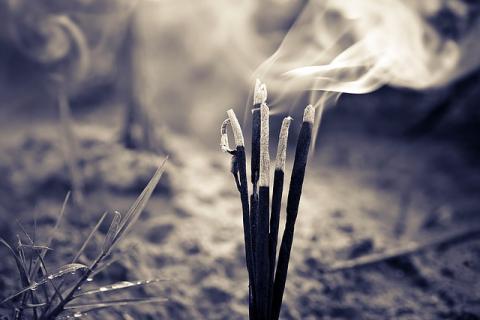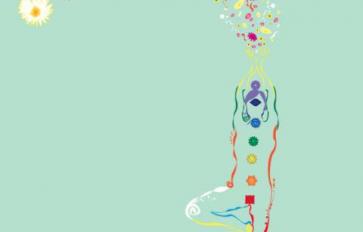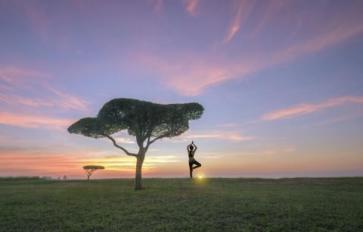
For many of us, death is not something we think about until someone close to us passes. We may find ourselves ill-equipped to handle the intense emotions that come with losing someone we love. We may not want to think about death as it could make us upset or frightened, yet it is the people who reflect upon dying that find both a deep gratitude for being alive and an urgency to focus on what matters most in this life.
I would like to share some of the yogic teachings on death and dying that have helped many reflect on the value of their lives, as well as find comfort in honoring the passing of those near and dear. Together we can ease our fears and grief and prepare to meet our own transition when our time comes.
One of the foundational teachings of yoga that serves us so beautiful when we come to thoughts on death is the realization that we are not our bodies. We learn through the teachings and through direct experience that what we are is more than blood and bone. There is a beautiful Buddhist reflection- “What was your face before you were born?” When we ask ourselves that question, we get an experience, a memory – that yes, there is something within us that existed before this physical body came into being, and to our great comfort we realize that that pure essence will live on after the body fades away. It is this realization that opens us up to a deep sense of peace at the idea of our own passing.
It also opens our hearts to experience those who have passed before us in a completely new way. We can really experience the essence of our loved ones- who they are beyond their human experience – and continue cultivating our relationship with them even though they are not here on the physical plane with us. When we realize that all beings live on beyond the physical world, we can find healing in our grieving and let go of our fears around dying.
For many of us, the idea of going somewhere we have not been before can evoke anxiety and fear. Death is a road we may dread traveling, but hearing a few common experiences from near-death-experiences and yogic teachings on what happens upon our passing can help us feel less afraid.
We have all heard stories of seeing “a great light,” a light so bright it was hard to see, during a near-death experience. In the yogic teachings, that light is your true self, your pure consciousness. There is nothing to fear in this powerful meeting. There are also stories of feeling a sense of peace and pure love and a longing to remain in that light.
In many near-death experiences there are family members or beings that say it is not time to go yet and there is still work to be done in the world, and so the soul must return, despite the deep desire to stay immersed in this great light.
In the tradition of Tibetan Buddhism there is an elaborate depiction of what happens upon passing and the path to follow “in the between.” Some of this is filled with the vast Tibetan Cosmology including Buddhas and wrathful demons. The key teaching for us to take away from this wisdom is that whatever appears to us – peaceful Buddhas or vicious demons – we must recognize it as our own consciousness and be fearless in both the powerful light and in the face of annihilation, as both are a reflection of the mind. We can take that teaching into our lives right now- how much of what we experience is really a reflection of our own psyche projected onto the world? Knowing this, how can we reshape our responses to the world around us?
There are additional teachings shared by Yogi Bhajan, the master that brought Kundalini Yoga to the West, that describe two paths that we are presented with upon dying. One path is warm, cozy and familiar, like a café. The other is cold, lonely and remote. It is the untrained psyche’s longing to return to that which is familiar and this choice would lead to a rebirth into a familiar state as the one we had left. The choice of the higher, more challenging path would lead us to a higher rebirth as a more awakened being. These two paths are a test that we put before ourselves to see where the works of this life dictate our next incarnation.
Yogi Bhajan also describes a review of life, similar to what we have heard described as “life flashing before our eyes.” Our entire life takes just 10 seconds to review! We then judge our own life- no external deity or force will do this, but you, reviewing and judging your own achievements and learning in this lifetime. Then we quickly decide our next rebirth. Again we are instructed to go beyond what is cozy and comfortable and aim for the highest possible incarnation.
These teachings are so relevant for us all. They are a call to always rise up and pick “the road less traveled” instead of the path of comfort and ease. It is this choice that helps us get out of bed to practice and meditate when we could be watching TV instead. It is the choice of soul growth over physical comfort that will aid us in living and dying as we make it a mental practice to push beyond our limitations.
As a child, I was always fascinated by death, and would reflect upon what it was that died, and what would live on. As I began teaching meditation, I realized that each time we meditate we are preparing ourselves for our own death- letting go of the ego, clearing the mind, so we can identify with the soul instead. Each fall I teach a workshop called the Yoga of Dying, inspired by that realization and the teachings on Dying from the traditions of Kundalini Yoga and Tibetan Buddhism. This fall as I was preparing to teach, I went walking amongst the falling leaves. I watched a leaf fall from high and thought of the fear I would feel to be that leaf. I realized in that moment that we all think we are the leaf and fear the impending fall, but really, we are the tree. The soul is the tree with roots deep and tall branches, we have weathered many autumns and will continue to do so. When the time comes the leaf of this life falls away, but the soul remains until all of its lessons are learned. Eventually, the Soul will merge back with that which created it. Wherever we are in our journey, it is that deep bliss of union with the Divine that awaits us.
I thank you for reading this. For taking time in this moment to find peace with your own passing. I also honor you as you feel the pain of separation with those who have passed before you. The further we go on this journey, the more clearly we see through the veils of separation and see that those that walked before us are still walking beside us, guiding us on our way back home.








